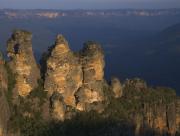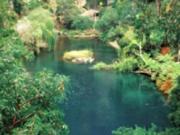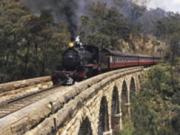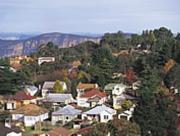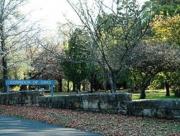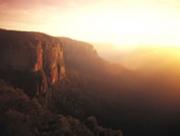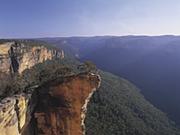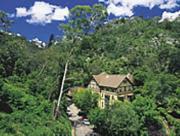The Blue Mountains, Sydney - Region Information
The Blue Mountains is Sydney's greatest recreation area for people who prefer the bush to the sea. They are part of the Great Dividing Range, which stretches from Gippsland region of Victoria in the south to the tropical rainforests of north Queensland.
The range rivals the Rockies in length, but nowhere near in height. Australia's highest mountain is Mount Kosciusko about 500 kilometres south of Sydney. At 2229 metres it is a mere baby by North American and European standards.
Yet the Blue Mountains, peaking at about 1000 metres, proved a heartbreaking challenge until they were conquered by a trio of explorers - Gregory Blaxland, William Lawson and Charles Wentworth in 1813. They and four men hacked through dense bush for 18 days to find a route. Sections of the Great Western Highway from Sydney still follow parts of their trail.
Blue Mountains Accommodation - Book your beautiful mountain hotel or resort in Katoomba and Leura now. Browse our stunning selection of four to five star properties, all of which are close to the Blue Mountains, The 3 Sisters, Wentworth Falls, The Katoomba Scenic Railway, Jenolan Caves and much more. Book accommodation and tours now.
The 'mountains', as they are commonly called, stood between the still fledgling settlement at Sydney and the agricultural and grazing country to the west. The conquest of the Blue Mountains opened up the vast grain growing and sheep grazing areas of New South Wales. East of the range the climate was too wet for wheat and sheep, which developed 'footrot', which literally caused their hooves to rot.
The settlement of the western slopes and plains established Australia's fine wool and wheat industries, which created great wealth and are still very important export industries. Australia led the world in the development of the Merino sheep, imported from South Africa. It is still the finest sheep wool in the world, gracing the backs of fashionable men and women from Rome to New York.
The Blue Mountains are so named because, from Sydney, they look blue. They are clad in vast forests of eucalypts (commonly called gum trees), which in the hot sun discharge a fine mist of eucalyptus oil from their leaves. The mist refracts light, which makes the haze look blue at a distance. That same oil makes the Australian bush as volatile as a pine forest in a bush (forest) fire. The vapour explodes, causing the fire to race through the canopy.
The first road was cut into the Blue Mountains by William Cox using a team of 30 convicts and eight guards. Starting at Emu Plains at the foothills in July 1814, they cut an incredible 47 miles to Mount York (past the highest point of the mountains at Mount Victoria - 1064 metres) in just four months. At the end of six months they completed 101 miles of road to Bathurst, which was founded as the major centre for agriculture on the western slopes.
The road was too steep for horse-drawn carriages until another branch was built from Mount Victoria to the historic township of Hartley in 1832. That could be considered the start of tourism to the area.
The first railway into the mountains, from Emu Plains to Wentworth Falls, opened in July 1867. Trains now run to Katoomba and beyond. The first motor car did not cross the Blue Mountains until 1904, and then it had to be hitched to a horse to make the steep incline up Mount Victoria. The advent of the motor coach opened the area to 'mass' tourism in the 1920s.
The rugged terrain of the Blue Mountains with its tree clad slopes and sheer sandstone cliffs attracts tens of thousands of visitors to its scenic beauty. Its first bushwalking club was set up in 1914. Scores of walking tracks lead along the ridges and down into its gorges. They range from an easy 10-minute stroll to good vantage points to challenging treks which can take a week or more.
Mountain biking (cycling) has become very popular and several operators will transport bikes to valley floors. Abseiling and canyoning with expert guides are also big attractions for novices and the experienced. The areas is dotted with waterfalls, and there is great variety in the vegetation as you descend into the valleys.
There are also four-wheel-drive tours of the area.
Localities
Katoomba
Katoomba is the largest town in the Blue Mountains though it was unknown until the Katoomba Coal Mine opened in 1879. Named after the Aboriginal tribe which inhabited the area, it is home to the most famous site in the mountains - the Three Sisters. Legend has it they were three beautiful young women who had fallen in love with three men from the Nepean tribe from the foothills.
Tribal lore prohibited the union, and a battle followed. A Katoomba witchdoctor turned the women to stone to prevent them coming to harm, but he was killed in the battle and no one else could undo his spell. They stand 906, 918 and 922 metres above sea level near the Echo Point lookout at Cliff Drive, about 2 kilometres from the town centre.
The coal mine left Katoomba with another of its great tourist attractions. The company cut a cable car track into the cliff face to bring coal from the valley floor. It is now used by the Scenic Railway to take visitors down the steepest railway incline in the world 300 metres to the floor of the Jamison Valley. The cars have clear sides and tops to ensure an uninterrupted view. It has been carrying passengers since 1935. Those who are feeling very fit and energetic can walk down the 800 steps of the Giant Stairway.
Near Echo Point and close to the Scenic Railway is the Scenic Skyway, which opened in 1958. A suspended box car holding 30 passengers travels 450 metres across the Jamison Valley, 300 metres (about 1000 feet) up. Both operate daily. People who are nervous of heights, and those who want to see more of the mountains, can get a helicopter view at the Maxvision Cinema at 225 Great Western Highway (on the way into town). Open daily, it features a film called The Edge shown on a six-storey high screen. Check for screening times as it shows other big screen features as well (phone 4782 8928).
The Explorers Tree, commemorating the crossing of the Blue Mountains by Blaxland, Wentworth and Lawson, stands by the highway about 2.5 kilometres west of Katoomba. It also marks the start of the 42 kilometre Six Foot Track which leads to Jenolan Caves. It is a 'comfortable' three-day walk and there are overnight camping areas on the way.
The Paragon is a living attraction in the main street of Katoomba, Katoomba Street. It's a café! Making its own confectionery since 1916, it has been carefully restored. Open daily 10am to 5pm except Mondays, it is probably the best know café in Australia. The staff add greatly to its old world character.
Katoomba's first hotel, built in 1882 and now known as The Carrington, is in the same street but is being renovated. The town has several art and craft galleries and a dozen restaurants.
Katoomba is just 110 kilometres from the centre of Sydney. The Western Freeway, which begins between Strathfield and Parramatta (off Parramatta Road which is the Great Western Highway - route 32) cuts out large sections of suburbia until it rejoins the highway at Emu Plains for the climb up the mountains. It puts Katoomba an easy 90-minute drive from the city, without stops. Trains run from the city in parallel with the highway, but it is impossible to enjoy many of the area's sights and attractions without a car.
Faulconbridge
Once you pass Emu Plains and start to climb the mountain highway the road is dotted with villages and small towns to Katoomba. The first one definitely worth a stop is Faulconbridge, about 85 kilometres from Sydney. It was the home of Sir Henry Parkes, who was the driving force behind Australia becoming a federation of states in 1901. His grave is in the cemetery in Sir Henry's Parade. In the same street, Jackson Park contains a corridor of oak trees planted by all Australian Prime Ministers or their families as a living memorial.
Much more famous, some would say for all the wrong reasons, was Australia's famous painter, Norman Lindsay, who outraged society with his sketches and paintings of naked women and demonic satyrs. His former home and garden is now the Norman Lindsay Gallery and Museum.
Born in 1879, Lindsay lived until he was 90. Apart from his love of the female form, Lindsay wrote on of Australia's most famous children's books, The Magic Pudding, and was fascinated with model sailing ships. Unless nudes offend you, the house museum is a treasure. The garden contains 15 of his fountains and sculptures. It is open daily from 10am to 4pm (phone 4751 1067).
Wentworth Falls
Eventually named for Charles Wentworth, Wentworth Falls offers some great views, its own waterfall, and walking tracks in the Valley of the Waters. It is about 105 kilometres from Sydney. Historic Tarella Cottage in Blaxland Road houses antiques and historic items, but it is only open at weekend in March and April and the first three weeks of October.
Yester Grange in Yester Road is a Victorian Country home set in 5 hectares of garden on a ridge above Wentworth Falls. Built in 1886, it has been maintained as a home of the era and includes a rotating exhibition of art and craft. Teas and light lunches are served. Open daily 10am to 4pm (phone 4757 1110). There is a handful of other galleries in the town.
Wentworth Falls Lake off Sinclair Crescent is a very pleasant picnic spot where you can swim or try your hand at catching a trout. It is the most accessible spot in the Blue Mountains at which to fish for trout. The rivers and streams are stocked with North American species, but many of them require more skill to get to than to fish in.
Leura
Just 2 kilometres farther is Leura, a pretty town with sweeping views from the Sublime Point Lookout at the end of Sublime Point Road. Other lookouts are at the Gordon Falls Reserve in Olympian Parade and the Leura Cascades off Cliff Drive.
The town is famous for its gardens and holds a garden festival every October when residents open their gates to visitors. The cooler climate suits many varieties of flowers and shrubs, which will not grow around Sydney. Leura's showcase is the Everglades Gardens at 37 Everglades Avenue. The garden was created by Paul Sorenson, acclaimed as Australia's master gardener, in the mid 1930s. Covering 6 hectares it is a formal garden of trees and shrubs. The Art Deco house is filled with memorabilia. Open daily 10am to 5pm (phone 4784 1938). The property is listed by The National Trust as part of Australia's heritage.
Big and little children can enjoy the Leuralla Toy and Railway Museum, housed in a historic mansion at the corner of Olympian Parade and Balmoral Road. It claims to have the largest collection in Australia of toys, dolls, teddy bears and model railways. Open daily 10am to 5pm (phone 4784 1169). Leura has several other galleries, including The Candy Store with displays of nostalgia, including postcards and ornate tins. Leura also has a golf course near the Fairmont Resort, and several up-market restaurants. Katoomba is 3 kilometres farther on.
Medlow Bath
Named by Governor Macquarie in 1815, Blackheath was one of the first Blue Mountains towns. It is peppered with lookouts of the Grose, Megalong and Kanimbla Valleys and is very popular as a quiet mountain retreat. The National Parks and Wildlife Service Heritage Centre has an exhibition centre at Govetts Leap Road which explains the geology, vegetation and history of the Blue Mountains. Open daily from 9am to 4.30pm (phone 4787 8877).
Blackheath is famous for the varieties of rhododendron, which flower in gardens throughout the town in November. The Bacchante Gardens in Bacchante Street has 1500 rhododendron and azalea bushes. It is open daily from 9am to 4pm. The town is a centre for art and craft.
Mount Victoria
Mount Victoria is the highest point in the Blue Mountains at 1064 metres above seas level. It is a small town with several lookouts and picnic spots, 126 kilometres from Sydney. The Mount Victoria Museum in the railway station has a country life and transport exhibition, but is only open weekends 2pm to 5pm. There is a local art gallery in the Old Vic Post Office, open weekends 10am to 5pm. It basically marks the end of the 'official' Blue Mountains.
Hartley
From Mount Victoria the Great Western Highway descends steeply through Victoria Pass. Though the road is wide and good, it is very steep and requires the driver to watch the road and not the scenery. Ten kilometres on, you come to Hartley (after passing Little Hartley) - an entire, tiny village which has been declared a historical site.
Hartley Historical Site is open every day from 10.00am -4.30pm except Christmas Eve and Christmas Day and located at Old Bathurst Rd, Hartley off the Great Western Highway. The court house runs tours on the hour with a minimum for 4 people per tour. The oldest building is an imposing sandstone courthouse built in 1837. There are seven other houses, a post office, an inn and two churches of note.
Jenolan Caves
If you have plenty of time and enjoy driving, the road to the Jenolan Caves starts less than a kilometre from the village, to the left. It is about a 50-kilometre drive, one way from Hartley. The surface is good, but it is winding and narrow in places and carries quite a lot of tourist coach traffic late morning and late afternoon. The Jenolan Caves nestle deep in a river valley and it is a very pretty drive. The valley is limestone with vegetation quite different to the rest of the mountains.
If you are already staying in the mountains, and it is late in the afternoon, leave it for the next day. The caves are worth a trip to themselves. They close in the late afternoon and the drive is tricky in the dark. If you have you luggage with you, try for a night at Caves House which has almost 80 rooms and is right next to the caves. Telephone first (6359 3304).
Discovered by a convict bushranger (outlaw or highwayman) in 1834, the complex contains nine huge limestone caves with amazing stalactites and stalagmites. (Remember, tights (the English term for pantyhose) come down, mites go up). They are beautifully lit and quite awesome.
Guided tours are held at regular intervals each day. You can not enter the caves on your own. Stairs and boardwalks traverse difficult areas. The entrance to the caves is capped by a huge stone arch which towers above the road. If you are just visiting, caves house serves meals.

